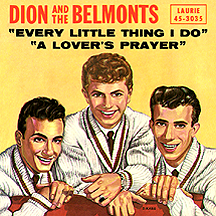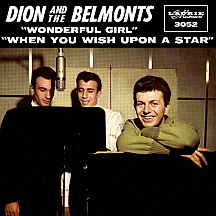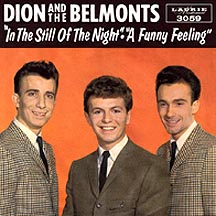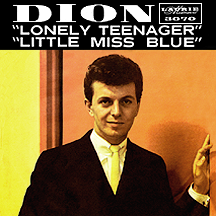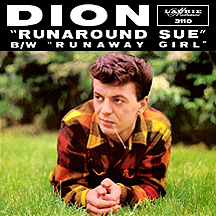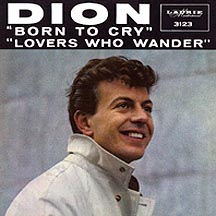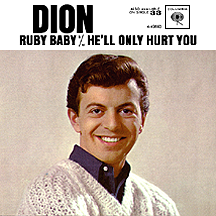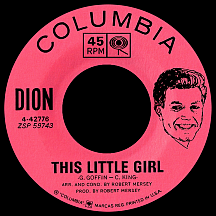DION
Of all the Italian-American teenagers singing street corner harmonies in the '50s, Bronx group The Belmonts, named for Belmont Avenue where they often sang together, made the most of it. Carlo Mastrangelo, Angelo D'Aleo and Fred Milano were all 17 in 1957 when they got together with Dion DiMucci, more introverted than they, also 17. Dion had been interested in music since he'd heard Hank Williams on the radio some five years earlier, and later when doo wop groups were becoming more obvious and rock and roll started to impact the airwaves, he became interested in trying to blend them all together, which some artists were already doing without necessarily planning it that way. Appearing in plays at school and entering talent contests helped him overcome his shyness. Later he would have to conquer something much more serious that he picked up on those very street corners: an addiction to heroin. It would trouble him for much of his adult life.
DiMucci had a natural gift for singing and found little difficulty in convincing Robert and Gene Schwartz, owners of the small local label Mohawk Records, to give him a shot. Searching for that first hit to establish the company, they likely undestimated Dion's potential marketability, though there could have been several reasons their association with the young artist was short-lived. The first Mohawk release was "The Chosen Few," featuring prerecorded vocal backing by The Timberlanes, a group Dion has said he never met. Then they teamed him with Carlo, Angelo and Fred in person, a group he could interact with and, in fact, knew from back in the days on Belmont Avenue. One Belmonts single was released on Mohawk, followed by the first Dion and the Belmonts record, "We Went Away," but none were successful.
The Schwartz brothers joined with Allan I. Sussel and established a new label, Laurie Records, while maintaining Mohawk as a separate company. Right off the bat, Dion and the Belmonts scored a top 40 hit in the spring of 1958 with the joyously uptempo vocal workout "I Wonder Why," written by Maxwell Anderson and Ricardo Weeks. Ken Hecht and Ernie Maresca supplied a ballad for their next release, "No One Knows," another hit. Ernie and Dion had hung out together a few years earlier in Bronx pool halls and would continue their working relationship for years to come.
With two big hits, the group began performing on a number of live shows...and Dion's career, and life, came dangerously close an end in February 1959. Booked on the "Winter Dance Party" headlined by Buddy Holly and The Crickets, the tour also starred The Big Bopper (J.P. Richardson), Ritchie Valens and Frankie Sardo. Future country star Waylon Jennings was also on the tour as a temporary member of the Crickets. When it was decided they would charter a small plane out of Clear Lake, Iowa to take three of the headliners ahead to the next venue in Fargo, North Dakota, the guys did some negotiating among themselves, coin flipping and the like, for seats on the plane. Dion could have flown, but declined to pay the fee of 36 dollars per passenger, opting instead to ride the tour bus with everyone else. This story, of course, is perhaps the most famous of all rock music tragedies...Holly, Richardson and Valens died when the plane crashed after takeoff in the wee hours of February 3. Dion survived and finished the tour under great distress to himself and everyone involved.
Life went on for Dion and the Belmonts, though the events surrounding the Winter Dance Party didn't provide immediate impetus for him to try to break the already problematic heroin habit. At least one hospital stay helped him get clean for a time, but it was several years before he finally kicked the habit. He was very good at hiding it from the public and managed to excel in his career while battling this one recurring demon. He and the Belmonts bounced back from the events of February '59, hitting the top ten for the first time with "A Teenager in Love," penned by the great Doc Pomus and Mort Shuman. Their biggest hit came as the 1960s began with a smooth teenage take on the Richard Rodgers and Lorenz Hart classic "Where or When" (first heard in the 1937 Broadway musical Babes in Arms). D'Aleo was drafted into the U.S. Navy shortly afterward and the group continued as a trio.
With the success of "Where or When," the label set the group on a different track, having them record standards like "When You Wish Upon a Star" (from Walt Disney's 1940 film Pinocchio) and Cole Porter's '37 composition "In the Still of the Night." In the fall of 1960, Dion and the remaining two Belmonts decided to go their separate ways. While they all insisted the split was amicable, each side having somewhat different visions of where they wanted to take their careers, it's likely that Dion's struggles with drugs had something to do with the decision. Angelo was released from the Navy after a short stint and rejoined Carlo and Fred. After an early '61 Laurie single, the Belmonts started their own label, Sabrina (later changed to Sabina for legal reasons) and enjoyed several hits over the next two years including "Tell Me Why" and "Come On Little Angel."
Dion didn't miss a beat. "Lonely Teenager," written by Salvatore Pippa, Alfred DiPaola and Silvio Faraci (borrowing more than just a little of the essence of Pomus and Shuman's "A Teenager in Love") was a hit at the end of the year. Problem was, while the Belmonts were content with pop remakes and teenage love songs, Dion favored rock, blues, country and R&B, planning to experiment with combinations of each whenever possible. Early on, he had avoided trying to write music, his childhood inhibitions perhaps holding him back as an adult. Maresca had a lot to do with helping him overcome that hesitation to write music, and a song they collaborated on in 1961 provided a breakthrough for DiMucci as a songwriter and singer. "Runaround Sue" took a tough, no-nonsense approach to the tale of a cheating ex-girlfriend (possibly based on a real person) and became a number one hit in October 1961. The Belmonts were nowhere in sight. Dion was a solo star.
Another group, The Del-Satins, were backing singers for Dion on many of his hits during this period. A Manhattan doo wop group who'd been around a few years without a breakthrough, Stan Zizka, Leslie Cauchi, Bobby Failla and brothers Fred and Tom Ferrara provided a more assertive rock sound than the Belmonts; they weren't given credit on the record labels, though, and some fans were under the impression the Belmonts were still recording with Dion. The early-'62 follow-up to his number one smash was "The Majestic," an infectious dance tune composed by Barbara Jones and Welton Young, but radio deejays preferred the flip side, Maresca's "The Wanderer," with a womanizing, devil-may-care lead vocal authentically delivered by Dion; the song reached number two on the charts in February and provided him with a nickname that stayed with him throughout his career.
Performances in the films Teenage Millionaire and Twist Around the Clock around this time helped increase his familiarity to audiences as a solo act. "Lovers Who Wander" (another DiMucci-Maresca song) became the third top ten single in a row, backed with the emotionally downbeat stunner "(I Was) Born to Cry," a solo songwriting effort by Dion that ranks among his best. Ernie Maresca broke out as a singer around this time with "Shout! Shout! (Knock Yourself Out)," a top ten hit despite his insistence that he couldn't sing (it was his only hit, though more than a dozen singles were released over the next seven years, but Ernie was happiest as a behind-the-scenes hitmaking writer). Dion was developing a flair for songwriting that he hadn't previously felt was possible, penning the 1962 hits "Little Diane" (one of only two top ten hits in the '60s with a kazoo break, the other being Joanie Sommers' "Johnny Get Angry," both sharing space in the national top 20 at the same time!) and "Love Came to Me" (in collaboration with John Falbo).
An offer from Columbia Records was too good to pass up and he signed with the major label near the end of 1962. The company, still fairly clueless when it came to rock and roll, had underserved some of the acts it had signed in the five years previous. Pop producer Robert Mersey picked up a few tricks in his attempts to bring out the best of Aretha Franklin's natural talent a year before and meshed well with Dion (while giving the singer a great deal of control over the recording sessions), resulting in a number two hit right off the bat, a deftly reconstructed interpretation of Jerry Leiber and Mike Stoller's 1956 Drifters hit "Ruby Baby," which he had been singing since his days with the Belmonts. Laurie Records continued releasing singles of earlier Dion recordings, doing well with "Sandy" (which he cowrote with Steve Brandt) and "Come Go With Me" (a worthy remake of the 1957 Dell-Vikings smash).
With two labels releasing material, 1963 turned out to be Dion's most hit-packed year. Gerry Goffin and Carole King's "This Little Girl" came next, then he took an odd U-turn with the spoken message song "Be Careful of Stones That You Throw" (first recorded by Hank Williams as Luke the Drifter more than a decade before), his one contribution to pop music's bizarre "death song" inclination of the early '60s. Next up, "Donna the Prima Donna" hit the scene ('...she wants to be just like Zsa Zsa Gabor!'), a girl who had at least a few dubious qualities in common with "Runaround Sue," contemptibly conjured by Dion and Ernie Maresca. With this top ten single he temporarily changed his name to Dion Di Muci (a curious misspelling), perhaps to distinguish himself from Dionne Warwick, who was gaining in popularity at the time. He closed out '63 with another major hit, redoing another Drifters/Leiber-Stoller '50s classic, "Drip Drop," with attitude.
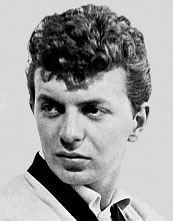
Dion kept digging into his roots as '64 began with folk-rockish renditions of Willie Dixon's "I'm Your Hoochie Cooche Man" and Chuck Berry's "Johnny B. Goode." Creatively he was right in the zone, but commercially he wasn't able to repeat, or even come close to, his peak years of 1961 through 1963. The Del-Satins moved on and he formed a new backing band, The Wanderers, with Falbo on guitar, Pete Falciglia on bass and Belmonts cohort Carlo Mastrangelo on drums. After three unfairly overlooked singles in 1965 and '66, Dion's association with Columbia was terminated. A reunion with the Belmonts in 1966 resulted in a couple of singles on the ABC label, but it seemed as though time had run out for all of them.
Having finally kicked the drug habit, Dion returned to Laurie Records. Label heads felt the song "Abraham, Martin and John" could be a hit for him. Written by Dick Holler (best known for the Swingin' Medallions hit "Double Shot (Of My Baby's Love)" and "Snoopy Vs. the Red Baron" by The Royal Guardsmen), the song was a tribute to assassinated Presidents Abraham Lincoln and John F. Kennedy and the more recent Martin Luther King, Jr. and Robert Kennedy tragedies. A top ten smash in November and December of 1968, it reestablished Dion's career and brought him a new following.
His music took a more "relevant" approach from this point on; in 1969 he reimagined the unimaginable, Jimi Hendrix's "Purple Haze," as a mellow contemplation piece, and remade Joni Mitchell's "From Both Sides Now" without varying much from the 1968 hit version by Judy Collins. After moving to Warner Bros. Records at the end of '69, he reflected on his own battle with substance abuse with the 1970 single "Your Own Back Yard." Dion reunited again with The Belmonts for a brief period, and in the years since has made records with producer Phil Spector and collaborated with many of his contemporaries, including Dave Edmunds and Paul Simon.
NOTABLE SINGLES:
- The Chosen Few - 1957
by Dion and the Timberlanes - I Wonder Why - 1958
by Dion and the Belmonts - No One Knows - 1958
by Dion and the Belmonts - Don't Pity Me - 1959
by Dion and the Belmonts - A Teenager in Love - 1959
by Dion and the Belmonts - Every Little Thing I Do - 1959
by Dion and the Belmonts - A Lover's Prayer - 1959
by Dion and the Belmonts - Where or When - 1960
by Dion and the Belmonts - When You Wish Upon a Star - 1960
by Dion and the Belmonts - In the Still of the Night - 1960
by Dion and the Belmonts - Lonely Teenager /
Little Miss Blue - 1960 - Havin' Fun - 1961
- Kissing Game - 1961
- Somebody Nobody Wants - 1961
- Runaround Sue - 1961
- The Majestic /
The Wanderer - 1962 - Lovers Who Wander /
(I Was) Born to Cry - 1962 - Little Diane - 1962
- Love Came to Me - 1962
- Ruby Baby - 1963
- Sandy - 1963
- This Little Girl - 1963
- Come Go With Me - 1963
- Be Careful of Stones That You Throw - 1963
- Lonely World - 1963
- Donna the Prima Donna - 1963
as Dion Di Muci - Drip Drop - 1963
as Dion Di Muci - I'm Your Hoochie Cooche Man - 1964
as Dion Di Muci - Johnny B. Goode - 1964
as Dion Di Muci - Abraham, Martin and John - 1968
- Purple Haze - 1969
- From Both Sides Now - 1969
- Your Own Back Yard - 1970


